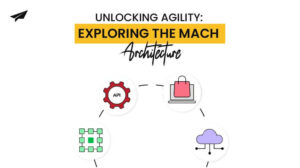Composable Architecture: Power of Modular Software Design
Composable Architecture has ushered in a new era of website development services, revolutionizing how businesses create and manage their online platforms. By embracing modularity, scalability, and personalization, companies can build websites that adapt to dynamic market conditions and deliver seamless user experiences. Composable empowers website development services to stay ahead of the competition and provides the foundation for a future-ready online presence. As businesses continue to explore innovative solutions, Composable Architecture remains a key driver in achieving digital success and customer satisfaction in the modern digital landscape.
Building flexible, scalable, and cost-efficient software systems is crucial for success in today’s rapidly evolving digital landscape. Traditional monolithic architectures have limitations, leading to increased complexity, maintenance challenges, and difficulties achieving omnichannel experiences. Composable Architecture offers a fresh approach to software design issues. It provides efficient and smooth solutions with various advantages.

Introducing Composable Commerce
Composable Commerce is a modern approach to e-commerce that has emerged as a response to the limitations of traditional monolithic e-commerce platforms. It fundamentally reimagines how businesses build, manage, and scale their digital commerce ecosystems. At its core, Composable Commerce advocates using modular, independent microservices that can be combined and orchestrated to create a flexible, agile, and personalized e-commerce experience for customers. Composable Commerce offers unparalleled flexibility in website development services. Businesses can easily customize their e-commerce platforms by leveraging modular microservices to meet their unique requirements. Companies can tailor their e-commerce components to fit their brand, audience, and goals, promoting innovation and staying ahead in a dynamic market.
Regarding website development services, Composable Architecture enables rapid development and continuous improvement. Web developers can create reusable components for various elements like headers, footers, navigation bars, and content sections. As a result, building and maintaining complex websites becomes significantly more manageable, leading to faster delivery times and improved client satisfaction.
Advantages of Composable Architecture
Scalability
The scalability of using Composable Architecture is a crucial advantage for businesses seeking to build flexible, adaptable, and future-ready systems. With a modular design and cloud-based infrastructures, organizations can quickly expand their applications to meet increasing demands, ensuring a seamless user experience and keeping up with the ever-changing digital environment.
Expansion
Using Composable Architecture for building and managing software systems offers numerous expansion opportunities. Architecture’s modular and flexible nature gives businesses a solid foundation to explore new avenues, cater to diverse user needs, and extend their offerings. With Composable, companies can easily integrate additional microservices to support these new offerings. This modular approach allows seamless expansion without disrupting the system, enabling businesses to diversify their product portfolios to meet customer demands. Composable Architecture allows enterprises to customize and tailor their applications based on regional or cultural requirements, ensuring a smooth entry into new markets.
Cost Efficiency
With Composable Architecture, you only have cost efficiency for the resources you need. As you can scale individual components independently, you can optimize resource allocation and minimize wastage. This cost-efficient approach is precious in cloud-based deployments, where scaling resources up or down directly impacts your expenditure.
Delivering an Omnichannel Experience
Composable Architecture enables businesses to create omnichannel experiences effortlessly. Building modular components that handle specific functionalities allows you to integrate them across various platforms, such as web, mobile, and IoT devices, providing users with a consistent experience.
Services Web Development
Composable Architecture is exceptionally well-suited for services web development. For instance, consider an e-commerce platform with multiple features like user authentication, product catalog, payment processing, and order fulfillment. These functionalities can be developed as independent modules and then composed to create a comprehensive web application. Web development is essential for businesses to interact with customers and streamline operations. It allows for seamless scaling and updates without impacting the entire system. Composable, with its power of modular software design, has transformed the way services web development is approached. This innovative approach emphasizes breaking down complex web systems into smaller, self-contained modules or microservices. Each microservice focuses on specific functionalities, such as user authentication, data management, payment processing, or communication with external APIs.
With services web development using Composable Architecture, developers can build these microservices independently and seamlessly integrate them to create a comprehensive web application. This modular approach offers numerous benefits for businesses creating scalable, flexible, and cost-efficient web solutions.
Real World Examples
Here are some real world examples of composable architecture.
Netflix
Netflix, the popular streaming service, is a prime example of Composable Architecture in action. Its platform is built upon microservices, which are essentially composable components. Each microservice caters to a specific aspect, such as user account management, content recommendation, or video streaming. This modular design has enabled Netflix to scale globally, provide a seamless user experience, and constantly introduce new features without affecting the entire system.
Uber
Uber’s success largely relies on its ability to deliver real-time transportation services seamlessly. Composable Architecture has played a vital role in achieving this. Uber’s architecture comprises microservices that manage various aspects of the ride-hailing process, including driver allocation, route calculation, payment processing, and user interface. This modular structure enables Uber to scale rapidly, support millions of users worldwide, and ensure high availability and responsiveness.
Airbnb
Airbnb, the popular marketplace for lodging and travel experiences, relies on Composable Architecture to manage its vast and diverse platform. Airbnb’s architecture allows them to offer personalized travel recommendations, manage bookings, process payments, and facilitate seamless communication between hosts and guests. This modular approach has enabled Airbnb to scale rapidly and offer a user-friendly, reliable platform, making it a preferred choice for travelers worldwide.
Conclusion
Composable Architecture represents a paradigm shift in software design, offering numerous benefits over traditional monolithic architectures. Composable sets a new standard in website development, enabling businesses to embrace change, adapt to emerging technologies, and deliver exceptional digital experiences to their audiences. Embracing the power of modular software design through Composable Architecture is a strategic move toward success in the competitive world of website development services. Its focus on modularity, scalability, cost efficiency, and omnichannel experiences makes it the ideal choice for businesses seeking to stay competitive in today’s dynamic digital landscape. Real-world examples from industry leaders like Netflix and Uber further validate its power in delivering robust and flexible software solutions. Embracing Composable Architecture is not just a technical decision; it’s a strategic move toward success in the ever-evolving world of software development.







